Learning Outcomes
- Meaning is clearly expressed through the use of a range of sentence structures, lengths, and types.
- The use of paragraph conventions and links between paragraphs in texts promotes coherence and cohesion in writing/signing. Their use is explained concerning logical progression, cause, and effect, and/or contrast.
- The overall structure of a piece of writing/signing is controlled and the conclusion is formulated
For you to be able to produce coherent and cohesive texts, there are certain things you need to do:
♦ Make your paragraphs coherent. If necessary, rearrange sentences for better paragraph flow and logic.
♦ Use the active voice whenever the passive voice is not more appropriate.
♦ Eliminate unnecessary words and phrases.
♦ Simplify your sentences. Break long sentences into manageable units.
♦ Condense repetitious or closely related material. Look for ways to combine or delete words and sentences that repeat information.
♦ Be specific. Replace vague phrases and words with more descriptive ones.
♦ Use words accurately. Look for phrases and words that don’t stand up to scrutiny. To achieve the above, you need to understand something about the structure of the English language.
The two fundamental parts of every English sentence are the subject and the predicate. A simple sentence can also be described as a group of words expressing a complete thought. Subjects can be described as the component that performs the action described by the Predicate.
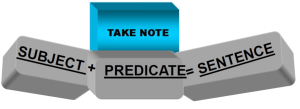
A simple sentence or independent clause must have a verb. A verb shows action or state of being. The subject tells who or what about the verb.
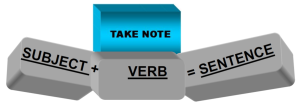
- What makes a complete sentence?
If it helps you, think about a sentence as if it were a skeleton, the skeleton contains various bones, and these bones are put together to form different parts of the body. So are sentences formed by words, the words are the bones and they are put together in different ways to form sentences.
1.1 Simple Sentences
A simple sentence contains a single subject and predicate. It describes only one thing, idea, or question, and has only one verb – it contains only an independent (main) clause. Any independent clause can stand alone as a sentence. It has a subject and a verb and expresses a complete thought
- Jill reads.
Even the addition of adjectives, adverbs, and prepositional phrases to a simple sentence does not change it into a complex sentence.
The brown dog with the red collar always barks loudly. Even if you join several nouns with a conjunction or several verbs with a conjunction, it remains a simple sentence.
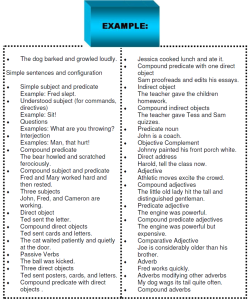
1.2 Compound Sentences
Compound sentences are made up of two or more simple sentences combined using a conjunction such as and, or but. They are made up of more than one independent clause joined together with a coordinating conjunction.
“The sun was setting in the west and the moon was just rising.”
♦ Each clause can stand alone as a sentence.
“The sun was setting in the west. The moon was just rising.”
Every clause is like a sentence with a subject and a verb. Coordinating conjunction goes in the middle of the sentence, it is the word that joins the two clauses together, the most common are (and, or, but) ♦ I walked to the shops, but my husband drove.
♦ I might watch the film, or I might visit my friends.
♦ My friend enjoyed the film, but she didn’t like the actor.
1.3 Complex Sentences
Complex sentences describe more than one thing or idea and have more than one verb in them. They are made up of more than one clause, an independent clause (which can stand by itself) and a dependent (subordinate) clause (which cannot stand by itself).
“My mother likes dogs that don’t bark.”
♦ Dependent clauses can be nominal, adverbial, or adjectival.
- The anatomy of a sentence
2.1 The Verb
The verb is the fundamental part of the sentence. The rest of the sentence, except the subject, depends very much on the verb. It is important to have a good knowledge of the forms used after each verb (verb patterns), for example: to tell
[someone] TO DO [something]
Here we can see that the verb to tell is followed immediately by a person (the indirect object, explained later), an infinitive with ‘to’, and, possibly, an object for the verb you substitute for DO.
Verbs also show a state of being. Such verbs, called BE VERBS or LINKING VERBS,
include words such as am, is, are, was, were, be, been, being, became, seem, appear,
and sometimes verbs of the senses like tastes feels, looks, hears, and smells.
“Beer and wine are my favorite drinks.” The verb “are” is a linking (be) verb.
Fortunately, there are only a limited number of different verb patterns. Verbs can describe the action (something the subject does) or state (something that is true of the subject) of the subject
- ACTION: I play football twice a week.
- STATE: I’ve got a car.
Some verbs can represent both actions and states, depending on the context.
- ACTION: David’s working in the bank.
- STATE: David works in a bank.
Finding the Verb
When you analyze a sentence, first identify the verb. The verb names and asserts the action or state of the sentence.
“Working at the computer all day made David’s headache.”
The main verb of the sentence is “made“, not working.
Verbs identify our activity or state
- eat, sleep, run, jump, study, think, digest, shout, walk…
2.2 The Subject
The subject is the person or thing the sentence is ‘about’. Often (but not always) it will be the first part of the sentence. The subject will usually be a noun phrase (a noun and the words, such as adjectives, that modify it) followed by a verb.
Finding the Subject
Once you determine the verb, ask a wh…? question of the verb. This will locate the subject(s).
♦ David works hard.
⇒ Who “works hard”?=David does=the subject.
⇒ Beer and wine are my favorite drinks.
⇒ What “are my favorite drinks”? Beer and wine
are the subjects.
A sentence’s subject(s) will answer the question, “who or what.”
2.3 The Predicate
Once you have identified the subject, the remainder of the sentence tells us what the subject does or did. This part of the sentence is the predicate of the sentence. The predicate always includes the verb and the words which come after the verb.
♦ Michael Schumacher drove the race car.
⇒ “Michael Schumacher” is the subject; “drove the race car” is the predicate.
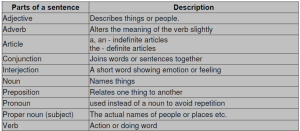
- Four Kinds of Sentences
Let’s look at four kinds of sentences: declarative, imperative, interrogative, and exclamatory.
♦ A declarative sentence makes a statement
- The hockey finals will be broadcast tomorrow
An imperative sentence gives a command or makes a request
Pass the puck to the open man.
- An interrogative sentence asks a question
Do you know the rules of hockey?
- An exclamatory sentence shows strong feelings.
Stop that man!
Declarative, imperative, or interrogative sentences can be made into exclamatory
sentences by punctuating them with an exclamation point.
- Paragraph conventions
Organize writing with a beginning, middle, and end:
♦ organize ideas into logical chunks of information (e.g. paragraphs)
♦ use transitions to connect episodes, descriptions, explanations, or facts (e.g. afterward, later on, in addition, also)
♦ describe procedures sequentially (e.g. steps in a scientific experiment)
♦ write a variety of beginnings and endings (e.g. begins with an amazing fact or background information; ends with something new to think about or a cliffhanger)
♦ organize narratives with an evident problem and solution
A paragraph is a coherent block of text, such as a group of related sentences that develop a single topic or a coherent part of a larger topic.
The beginning of a paragraph is indicated by………
♦ the beginning of the content, that is, the paragraph is the first content in the document, or
♦ exactly one blank line preceding the paragraph text
The end of a paragraph is indicated by ………….
♦ the end of the content, that is, the paragraph is the last content in the document, or
♦ one or more blank lines following the paragraph text
A paragraph should:
♦ have a topic sentence:
a topic sentence is a sentence whose main idea controls the rest of the paragraph and is usually the first sentence of the paragraph, but not necessarily, it may even be at the end of the paragraph
- Have a body
The body of a paragraph explains, develops, or supports, with evidence, the topic sentence’s main idea – it usually consists of supporting ideas.
- be coherent
Supporting ideas must relate to the topic sentence – when sentences are connected or organized in a paragraph, a reader can easily follow a writer’s train of thought. A writer can use a variety of coherence devices, such as conjunctions, and pronouns, to achieve overall paragraph coherence (conjunctions – join words together; pronouns – connect ideas)
Conjunctions:
As their name implies, conjunctions join together elements of thought – words, phrases, sentences, and paragraphs. Coordinating conjunctions are the simplest kind, and they denote equality of relationship between the ideas they join. Their relatives, correlative conjunctions, not only denote equality but also make the joining tighter and more emphatic.

John and Sally built a fish pond.
♦ The train was late, and Tom was tired.
♦ Just as the smell of baking brought back memories, so too did the taste of the cider.
Coordinating and correlative conjunctions are great when two ideas are of the same importance, but many times one idea is more important than another. Subordinating intersections allows a writer to show which idea is more and which is less critical. The idea in the main clause is more important, while the idea in the subordinate clause (made subordinate by the subordinating conjunction) is less critical. The subordinate clause supplies a time, reason, condition, and so on for the main clause.
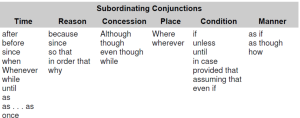
♦ Sally steamed the corn while Fred fried the steaks.
♦ After the rain stopped, the dog ran into the mud to play.
♦ The snowman melted because the sun came out.
♦ Even though John fell asleep, the telephone salesman kept talking.
Conjunctive adverbs make up an even stronger category of conjunctions. They show logical relationships between two independent sentences, between sections of paragraphs, or between entire paragraphs. Conjunctive adverbs are so emphatic that they should be used sparingly; however, when used appropriately, they can be quite effective.

| EXAMPLE |
| If the salmon is grilled, I will have that; otherwise, I might have the chicken.
♦ James has a garage full of woodworking tools. He might, however, have some metric wrenches, too. ♦ I do not recommend that you play with a stick of dynamite lit at both ends. Rather, a ham sandwich would be better for you. |

Relative pronouns and relative adjectives are also used to join ideas together by creating adjective or noun clauses, which allow a writer to create smoother, more flowing and effective sentences by combining ideas.
| EXAMPLE |
| This is the man who sells peanuts.
♦ Tell me what you want. ♦ Hers is an idea that I would like to think through. ♦ The shirts, which are in the laundry, will need ironing. |
Adverbs of time, place, and sequence are actually transitions of logic, but as such they also have conjunctive force, because they connect ideas by showing a time relationship.

The twilight glides away. Soon night will awake.
♦ First, get a pad and pencil. Next, find a quiet place to think.
Expletives are closely related to conjunctive adverbs. The “official” line on expletives is that they convey no meaning of their own but instead serve only to emphasize the statement to which
they are attached. As such, then, they technically do not show a logical relationship like time or cause between ideas, and that fact prevents them from being true-blue conjunctive adverbs. But it could be argued that expletives create a relationship of emphasis between ideas: this new idea is important in light of what preceded it. Indeed, that is why they are included here.

| EXAMPLE |
| The flashlight hit the floor and broke into a hundred pieces. At least there was a candle in the room.
♦ They all began to use appropriate expletives in their writing. They were convinced, I suppose, by the excellent examples. ♦ The conjunction list has left the building. On the whole, I hope you enjoyed it. |
Pronouns:
Pronouns are words that can replace or substitute a noun or a noun phrase.
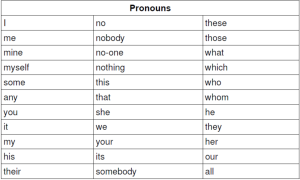
| EXAMPLE |
| Clutching the coin, Maria ran to the shop. She went straight to the counter and bought the sweets. (“She” replaces the noun ‘Maria’)
♦ The 8-mile walk passes through parkland and woodland. It takes you alongside many points of interest, including a disused airfield. (“It” replaces the noun phrase ‘the 8-mile walk’) |
CONCLUSION!
First and last impressions are important in any part of life, especially in writing. The introduction is what makes the reader want to continue reading your paper. The conclusion is what makes your paper stick in the reader’s mind. The conclusion to any paper is the final impression that can be made. It is the last opportunity to get your point across to the reader and leave the reader feeling as if he or she learned something.
Leave a Reply
You must be logged in to post a comment.